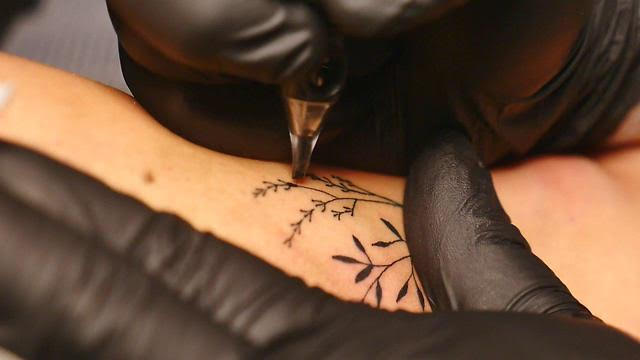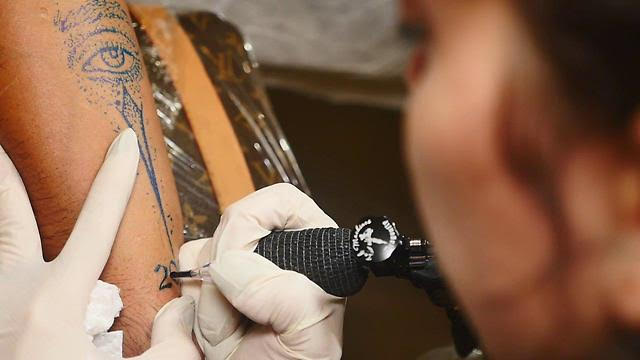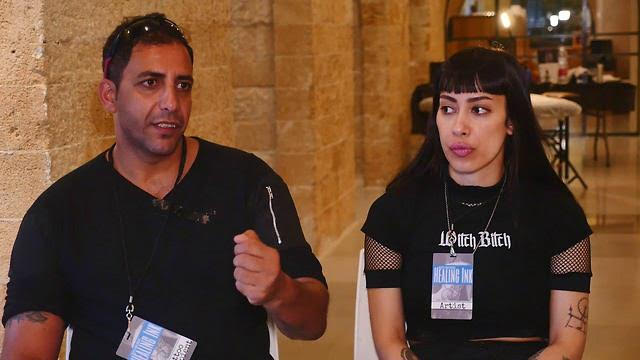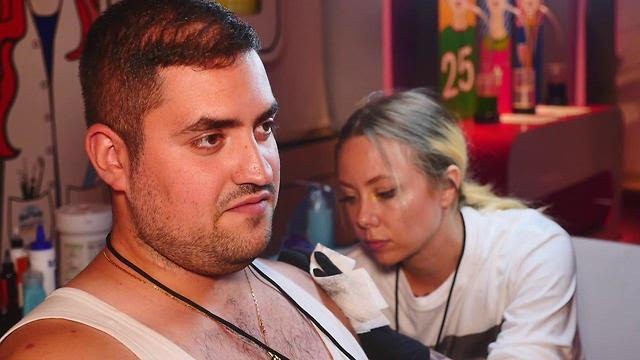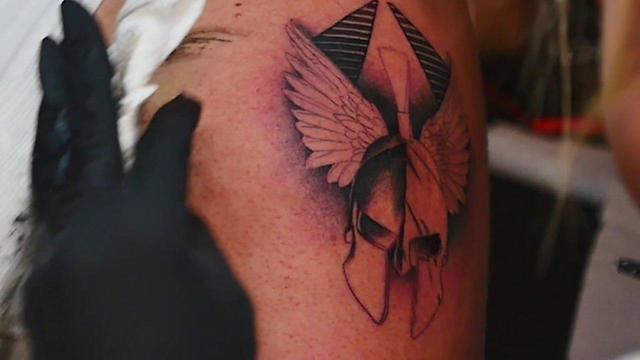Getting your Trinity Audio player ready...
Ten of the world's leading tattoo artists recently arrived in Israel to offer their specialist skills to "Healing Ink," a project that helps people cope with post traumatic stress disorder (PTSD) due to violence.
Among the Israelis suffering from PTSD who turned up at the Israel National Museum of Science, Technology and Space in Haifa for a tattoo was Leah Gavish Georgy, who on Passover 2002, lost her mother Rachel, father David, brother Abraham and grandfather Yitzhak when a Palestinian terrorist broke into their home at the Elon Moreh settlement.
6 View gallery
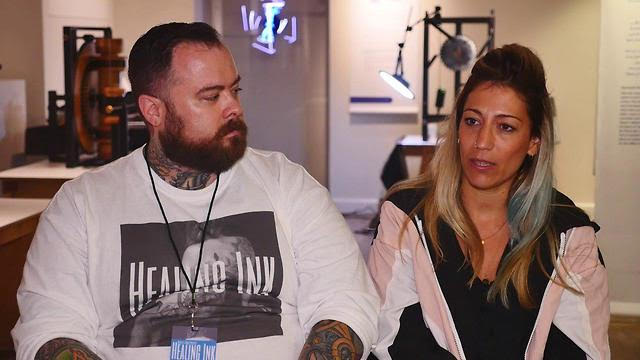

Terror survivor Leah Gavish Georgy with tattoo artist Russ Abbott
(Photo: Yaron Sharon)
Leah, then 17, hid in the attic with three other family members, which allowed her to survive the murderous attack.
Now, 17 years on, she is celebrating her survival with a special personalized tattoo of blooming flowers and pristine leaves.
"It's a sign of growth and evolution for me, and that is something I wish upon myself for the rest of my days," she says.
"I decided not to tattoo something that relates to my parents or brother, but rather something that relates to my life."
Guy Mugrabi was serving in the Border Police in 2001, when during a routine patrol in the streets of Jerusalem, he and his partner spotted a suspicious-looking man wearing a yarmulke.
As they got closer, the man activated a bomb with a trigger he had hidden in his bag. Mugrabi's injuries were considered somewhat light, while his partner suffered critical wounds.
The tattoo Mugrabi designed with his wife is that of a clock pointing to the year 2001, with an open staring eye in its middle, a symbol of his struggle with PTSD.
"When you see people who struggle with PTSD you can usually see they have sad or blank eyes," says Mugrabi. "When I was injured you could see it in my eyes - that blank stare, that's what PTSD looks like."
Chen Schwartz was a soldier in the Armored Corps when an unknown man tapped him on the shoulder in Jerusalem in August 2014, as Schwartz turned around, the man fired three rounds into his stomach.
Schwartz was critically wounded but was treated at the scene by a police paramedic. He later received lifesaving surgery at Hadassah hospital in the capital.
Schwartz's ink was designed by him and New York tattoo artist Megan Massacre.
"My tattoo is comprised of three parts," says Schwartz. "The first part is the tracks of the tanks depicted in my squad's emblem, which is meant to represent who I was at the time of the incident. The second part is phoenix wings meant to represent rebirth, and the third is a helmet, meant to signify the blood, sweat and tears I poured into my rehabilitation for the past five years."
Healing Ink was brought to Israel by the "Artists 4 Israel" organization, and the tattoos serve as a literal representation of the victims' ability to take back control of their bodies - forming an integral part of their mental recuperation.
Some of the project's participants choose to cover existing scars with tattoos, while others opt to amend an existing tattoo and give it a whole new meaning.
"The physical injuries are minor," says Mugrabi. "The real injury is the PTSD, and it's still as strong as the day after the incident. All the symptoms are still there, lack of sleep and so on."
Mugrabi says the tattoo he received helps him to accept the pain he's still feeling years after the explosion.
"I accept the PTSD and accompanying suffering with love, and my new tattoo is a symbol of that acceptance."
For Mugrabi's tattoo artist, Edith Ben-Gida, this is the second year she has participated in the Healing Ink project.
"It's a beautiful thing that grows out of the tattoo's pain," says Gida.
"I believe that if the process of getting a tattoo didn't involve pain, the whole PTSD healing procedure wouldn't be the same. A tattoo's pain signals something good, a change."
Gida says those who choose to cover scars with a tattoo usually find new appreciation for a previously disfigured body part.
"Their new tattoo carries a new memory with it, and so when they look at the tattoo, it brings them joy, and that's always a good thing."
Years after the incident, Schwartz still uses a cane in order to get around, and says his PTSD is present in every aspect of his life.
"Every second person you look at appears to be suspicious," he says. "It took me a month to be able to drive around my home town, and being able to sit with my back to the door took me another two years."
Schwartz says that even meeting up with his friends was a struggle.
"Going out with my mates took me years, you basically lose all control of your life, I'm even receiving psychological treatment five years on from the incident," he says.
"The tattoos we got here today represent a kind of a closure," Schwartz says. "Everywhere you go, the scars go with you, so at least now I have something on my body I'm proud of, something I chose to have."
Russ Abbott, a tattoo artist from Roswell, Georgia, believes the element of choice plays an important part in the healing process.
"By choosing to get tattooed, the person goes through a process of mental healing," he says.
"Some people get tattoos because they simply love getting tattooed," he adds, "but healing via tattoos is a whole different story I believe."
Abbot says that from the very first time he participated in the Healing Ink project, he understood what the project meant to its participants.
"When I first took part in the project two years ago, I tattooed two women who had been through a traumatic experience," he says. "The very decision to get tattooed help them regain a sense of control over their bodies."
According to Megan Massacre, she first volunteered with the sole intent of making art.
"I initially just wanted to create cool tattoos, it never occurred to me I could give people tattoos that would help them change their lives," she says.
Artist 4 Israel CEO Craig Dershowitz says he's aware of how much of a difference the project makes to the participants.
"I'm talking to some of those that took part in the project, and it totally changed their lives to one degree or another," he says.
"The mother of one of the participants told me he never used to go out of the house, he was too shy and scared," Dershowitz says, "now he's an advocate for people who were injured under various circumstances."
Healing Ink also helps people around America, and according to Dershowitz, Israelis tend to deal with trauma a bit differently than others.
"Those in Israel are usually much younger, so they tend to deal with the trauma through humor," he says.
"I tend to tell my artists that when it comes to Israelis, the funnier the person, the deeper the trauma."


